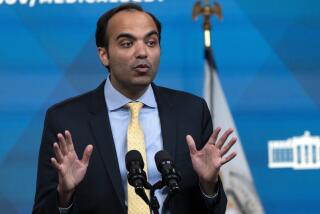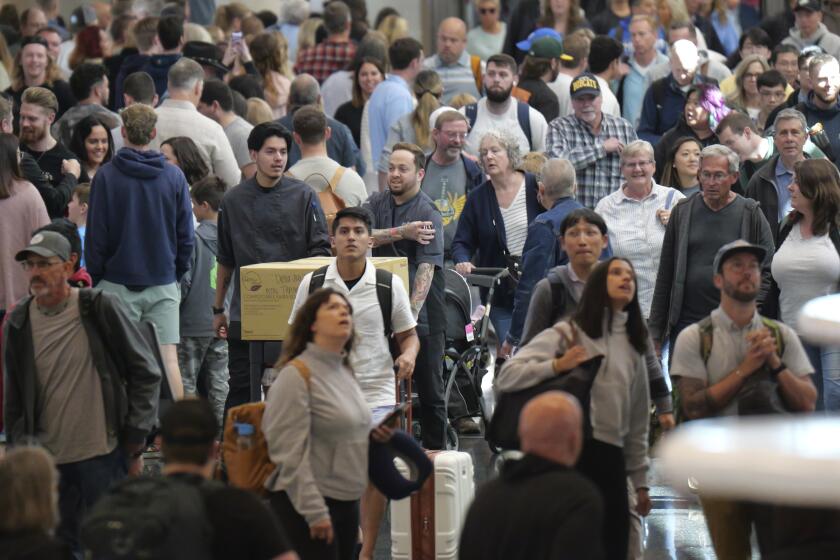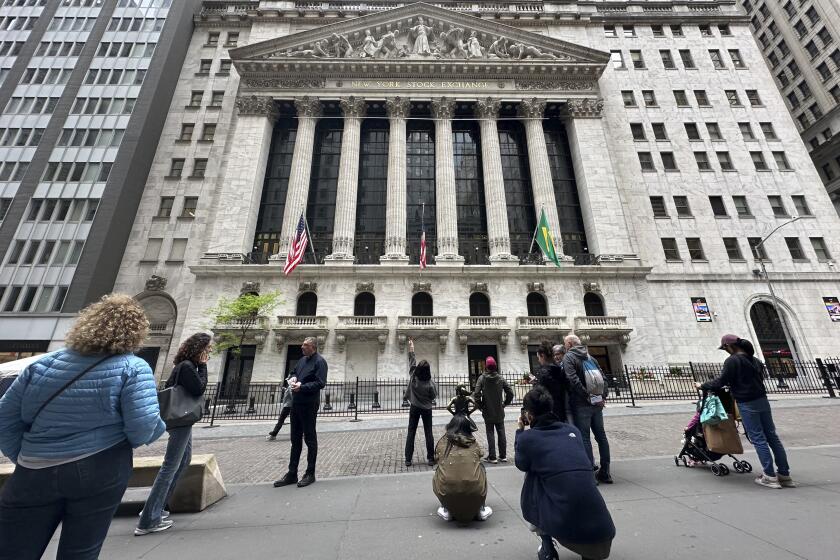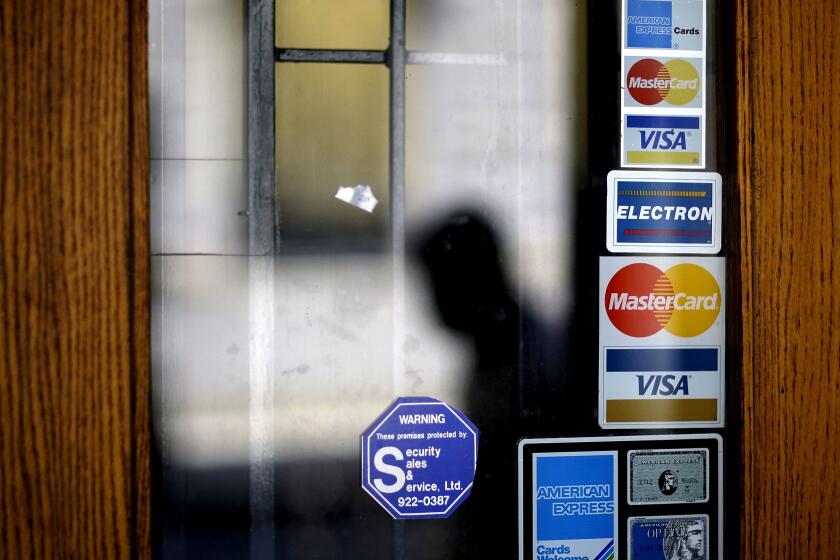Unions Face Unsettling Times in the Valley : Labor: The erosion of aerospace and automotive jobs cuts membership and the bad economy weakens organizing drives. But bright spots exist.
Across the street from the United Auto Workers’ hall in North Hollywood stands a 50-foot-high rock pile. To Jerry Augustine, financial secretary of UAW Local 179, it is a bitter sign of what has happened to his labor union in the past few years.
The pile is all that is left of a once-bustling factory that provided high-paying jobs for hundreds of UAW members, before Bendix shifted much of that work to non-union facilities elsewhere and then earlier this year crushed the plant into pieces.
“That’s our plant there, all ground up,” Augustine said, his face grimacing. “It’s very depressing.”
These are unsettling times for the labor movement. As Bendix and other manufacturers have closed or cut back because of the sagging economy and other problems, they have left behind a trail of withering unions in the Southland.
And organizing new members has become more difficult because Los Angeles County’s high unemployment rate--9.1% in May--has created a large surplus of workers, giving employers an edge to thwart unionizing campaigns.
The toll on unions has been especially heavy because of the erosion of aerospace and automotive jobs in the Valley.
UAW Local 645 and International Assn. of Machinists District 727--once the pillars of the Valley’s labor movement--between them have lost about 9,000 members in the past five years. Most of the losses were due to the closing of the General Motors plant in Van Nuys last year and deep cuts at Lockheed Corp., the Calabasas-based aerospace firm.
“The Valley’s more industrial than other areas, so it’s taken the biggest hits,” said Chuck Sheehan, a representative of the Los Angeles County Federation of Labor, an umbrella organization of about 500 locals in the Southland.
But it’s not just the industrial unions.
With new construction down, Valley unions in the building trades are struggling.
And entertainment industry unions such as the International Alliance of Stage and Theatrical Employees Local 695 say that while their membership hasn’t slipped, they are not getting much work for their members because studios are shifting work to non-union labor.
Overall, the county’s Federation of Labor represents about 700,000 union members, or about 15.5% of Los Angeles County’s labor force--down from more than 25% of the work force in the 1950s.
As in the nation, union membership in the county has dropped steadily in the past decade, Sheehan said. But the decline has sharpened in the past five years as the local economy has deteriorated, with membership falling between 5% and 10% a year, Sheehan said.
The membership drop has probably been steeper for union locals in the Valley. Unlike the Rust Belt and central and East Los Angeles, which lost manufacturing jobs more than a decade ago, the deindustrialization in the Valley occurred more recently.
Despite the union decline, labor leaders argue that unions remain influential in the Valley, because they still represent about 200,000 people.
There remain large, unionized work forces at beer-maker Anheuser-Busch in Van Nuys, at Price Pfister, a plumbing manufacturer in Pacoima, and aerospace concern Rocketdyne in Canoga Park.
There are also bright spots in the labor movement. They include unions in the food and other service industries. And public-sector unions, which represent teachers and government workers, continue to grow, now accounting for about 30% of the county’s total union membership.
“Many political candidates still look to us,” said Alan Lewis, head of a painters’ local in Van Nuys and chairman of the Valley Labor Political Education Council, a coalition of locals based in the Valley.
Lewis said the council makes some political donations, but it can also influence members’ votes and deliver organizational help with telephone banks and voter registration drives.
Labor leaders also see a ray of hope with the Clinton Administration, particularly after Republicans in the White House who often ran counter to organized labor’s interests.
Among things that could help, Clinton is expected to appoint two members on the five-member National Labor Relations Board, the federal agency that enforces labor laws.
The United Food & Commercial Workers Local 770 is an example of a union that has held steady during troubling times. The local represents 30,000 workers in Los Angeles County, including 10,000 in the Valley. Most of them are workers at supermarkets.
“Our jobs can’t be exported,” said Rod Diamond, vice president at the local, which is based in Los Angeles. It also helps that virtually all of the major supermarket chains that operate in the Valley are unionized, and analysts say the union is quick to seize new stores.
But the UFCW isn’t without challenges. Perhaps the biggest threat are efforts by big non-union discount retailers to expand in the Valley.
The union campaigned against Wal-Mart opening in Burbank, a plan that the company has since dropped. Wal-Mart is still looking for sites in the area, and so apparently are warehouse food clubs such as PACE and Costco.
The UFCW would like to unionize some of the growing ethnic grocery stores in the Valley. But it has not been easy.
Unions overall have done little organizing of the increasing Latino work force in the Valley, said Rudy Acuna, professor of Chicano studies at Cal State Northridge.
Analysts say part of the difficulty is that immigrant workers are often scared of joining unions because they are fearful of losing their jobs, or because they are illegal immigrants.
UFCW Local 770, because of its size, takes in nearly $10 million annually in dues. So it is better equipped than most to organize.
But many of the smaller locals in the Valley lack sufficient resources to organize new members. “We need more funding and staffing,” said Augustine, the UAW Local 179 officer.
Since Augustine took office in 1984, UAW Local 179 has lost more than half of its 950 active members, and its dues revenue shrunk from $242,769 in 1990 to $169,265 last year, according to Labor Department reports.
After paying for salary and other office expenses, there isn’t much left to fund organizing efforts.
The last time that UAW Local 179 organized a shop, it was stymied by employer resistance.
In 1989, Augustine’s local unionized about 50 workers at Refuse Compactor Services in Sylmar. But the union was unable to negotiate a satisfactory contract.
So later in 1989, the union struck the company. But after several months the strike was canceled because it wasn’t having much effect, and the company continued to operate with replacement workers.
The union filed numerous grievances with the federal labor board against the company for allegedly running forklifts into picketing employees and burning union picket signs.
It wasn’t until earlier this year that the labor board sided with the UAW in its grievances.
But the union has yet to recover back pay from Refuse Compactor Services for its striking members, some of whom have been working off and on ever since and living on $100 a week in strike checks from the union.
“You can violate the federal labor law with impunity and nothing happens,” said Larry Steinsapir, a labor lawyer in Los Angeles. Countered Harry Stang, a lawyer who represents management in labor cases, “I think responsible employers in the Valley address issues of organizing in a lawful way.”
Stang added that unions aren’t helping employers enough during tough times, when many businesses are threatening to leave because of workers’ compensation problems and other factors contributing to the so-called inhospitable business climate in Southern California.
“Unions are really facing difficult circumstances,” said Daniel Mitchell, a UCLA professor who studies labor issues. “It’s always harder to deal in a sagging economy.”
At Machinists District 727 in Burbank, union leaders aren’t waiting for the economy to get better.
More than any other union local in the Valley, District 727, which represents Lockheed workers, has seen the biggest erosion of membership.
District 727 had more than 40,000 members in the late 1940s, making it one of the biggest and most powerful union locals in the country.
But as Lockheed consolidated work in Burbank to facilities in Georgia and other sites, District 727 has seen its membership plummet to 2,500 members.
Don Nakamoto, research director at District 727, said the decline has forced the union local to reduce its staff drastically, but has also brought a realization that the local must operate differently if it is to survive.
Since 1990, he said, District 727 set out on a new path to focus on developing jobs in the commercial sector.
Besides working more closely with political officials in defense conversion plans, District 727 has tried to encourage its members to get involved in the development of electric cars and other transportation areas that could utilize their skills.
For instance, the union is trying to work with an aerospace-parts maker, HR Textron in Valencia, to develop products that can be sold to automotive, robotics and other commercial industries.
At stake are 300 union jobs that remain at HR Textron, Nakamoto said.
But such efforts are not very likely to pay off anytime soon, he said. “I don’t think we’re looking for any meaningful results until 1996.”







